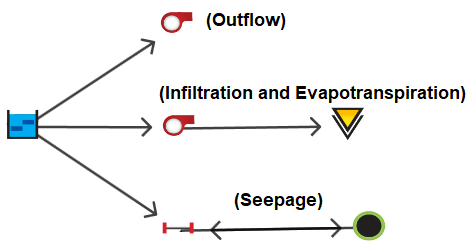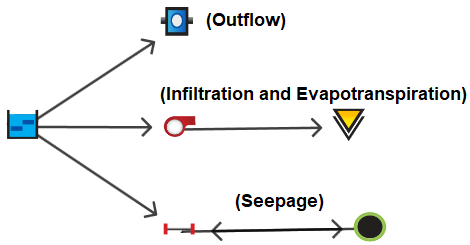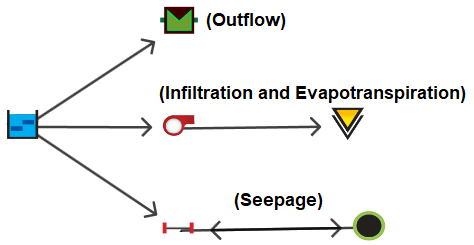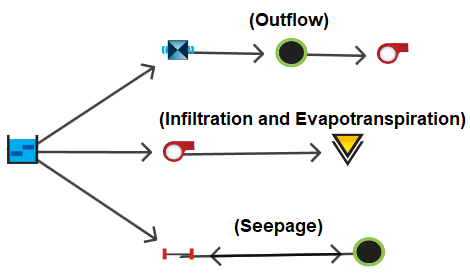In general, the main structure of the wetland is modeled as a Storage Unit in VO SWMM. The wetland outflow is modeled using different structures based on wetland outlet type. The infiltration and evapotranspiration from the fringe area and the evapotranspiration from the storage area are lumped together and modeled by a Pump. If there is a modeling result, the infiltration and evapotranspiration will be added and assigned as a time-series dataset to this Pump by a Control Rule. The seepage is modeled by a Conduit and a Junction at the upstream of the Conduit. Please note that the Conduit has a circular shape, a length of 50, and a diameter of 1. Users should evaluate these assumptions and make adjustments if needed. If there is a modeling result, the opposite of the seepage results will be used, because the flow is defined from the Junction to the Conduit, and assigned as time-series data at the Junction inflow.
Wetland Outlet Type is Stage Discharge Curve or Storage Indication
| OTTHYMO object | VOSWMM object |
|---|---|
| RouteWetland |
Storage Unit with Pumps, Conduit, Junction and Outfall. The Storage Unit is used to model the main structure of Wetland. For other objects, please refer to the scheme. |
The parameters of VO SWMM Storage Unit are assigned as:
- NHYD = Wetland NHYD
- Name = Wetland Name
- Full Depth = the last cell of the STAGE column of Wetland Depth-Area Curve
- Initial Depth = Initial Water Depth
- Storage Curve = Tabular
- Storage Curve Table = Depth-Area Curve
- Other parameters keep as default as in VOSWMM.
The parameters of VO SWMM Outlet used for Outflow are assigned as:
- NHYD = Wetland-NHYD[x]-Outflow, where x is the NHYD of the wetland
- Name = Wetland-NHYD[x]-Outflow, where x is the NHYD of the wetland
- Pump curve
- Curve type = TYPE4
- Curve name = Wetland-NHYD[x]-Outflow, where x is NHYD of the wetland
- Curve table = Wetland Discharge Curve
- Other parameters keep as default as in VOSWMM.
The parameters of VO SWMM Pump used for infiltration and evapotranspiration are assigned as:
- NHYD = Wetland-NHYD[x]-InfilET, where x is the NHYD of the wetland
- Name = Wetland-NHYD[x]-InfilET, where x is the NHYD of the wetland
- Pump curve
- Curve type = TYPE4
- Curve name = Wetland-NHYD[x]-InfilET, where x is NHYD of the wetland
- Curve table:
- If there is simulation result: Depth = 0, Flow = 1
- If there is no simulation result: Depth = 0, Flow = 0
- If there is simulation result, in Control Rule, add a rule:
RULE R[i]
IF SIMULATION TIME > 0
THEN PUMP Wetland-NHYD[x]-InfilET SETTING = TIMESERIES [selectedRunName]-Wetland-NHYD[x]-InfilET
where i is the rule number that will be automatically generated from the program, and [selectedRunName]-Wetland-NHYD[x]-InfilET is the Name of time-series data used for infiltration and evapotranspiration. - Other parameters keep as default as in VOSWMM.
The parameters of VO SWMM Outfall used for infiltration and evapotranspiration:
- Use the default values as in VOSWMM.
The parameters of VO SWMM Conduit used for seepage are assigned as:
- NHYD = Wetland-NHYD[x]-Seepage, where x is the NHYD of the wetland
- Name = Wetland-NHYD[x]-Seepage, where x is the NHYD of the wetland
- Shape = Circular
- Shape Full Depth = 1. Conduit Full Depth and Geom1 will be updated automatically in VOSWMM.
- Length = 50
- Other parameters keep as default as in VOSWMM.
- Users should check these values and make adjustment if needed.
The parameters of VO SWMM Junction used for seepage are assigned as:
- Inflow = Yes
- Inflow Editor
- If there is simulation result
- Time Series = [selectedRunName]-Wetland-NHYD[x]-Seepage
- Time Series Value column = – Wetland Seepage Value
- Time Series Date-Time column = Wetland Seepage Date-Time
- Scale Factor = 1
- Time Series = [selectedRunName]-Wetland-NHYD[x]-Seepage
- If there is no simulation result: no need to add inflow
- If there is simulation result
- Other parameters keep as default as in VOSWMM.
Wetland Outlet Type is Orifice
| OTTHYMO object | VOSWMM object |
|---|---|
| RouteWetland |
Storage Unit with Pump, Orifice, Conduit, Junction and Outfall. The Storage Unit is used to model the main structure of Wetland. For other objects, please refer to the scheme. |
The conversion and assignment of the parameters of these objects follow the same way as when the wetland outlet type is Stage Discharge Curve or Storage Indication: Storage Unit, Pump and Outfall used for infiltration and evapotranspiration, and Conduit and Junction used for seepage.
The parameters of VO SWMM Orifice used for Outflow are assigned:
- NHYD = Wetland-NHYD[x]-Outflow, where x is the NHYD of the wetland
- Name = Wetland-NHYD[x]-Outflow, where x is the NHYD of the wetland
- Type = Bottom
- Shape = Rect_Closed
- Height = (Wetland Outlet Orifice Area)^0.5
- Width = (Wetland Outlet Orifice Area)^0.5
- Discharge Coeff = Wetland Outlet Orifice Co.
- Flap Gate = Yes
- Other parameters keep as default as in VOSWMM.
Wetland Outlet Type is Weir
| OTTHYMO object | VOSWMM object |
|---|---|
| RouteWetland |
Storage Unit with Pump, Weir, Conduit, Junction and Outfall. The Storage Unit is used to model the main structure of Wetland. For other objects, please refer to the scheme. |
The conversion and assignment of the parameters of these objects follow the same way as when wetland outlet type is Stage Discharge Curve or Storage Indication: Storage Unit, Pump and Outfall used for infiltration and evapotranspiration, and Conduit and Junction used for seepage.
The parameters of VO SWMM Weir used for Outflow are assigned as:
- NHYD = Wetland-NHYD[x]-Outflow, where x is the NHYD of the wetland
- Name = Wetland-NHYD[x]-Outflow, where x is the NHYD of the wetland
- Type
- If wetland type is Rectangular, Weir Type = TRANSVERSE
- If wetland type is Triangular, Weir Type = V-NOTCH
- If wetland type is Trapezoidal, Weir Type = TRAPEZOIDAL
- Height = Wetland Outlet Height
- Length
- If wetland type is Rectangular or Trapezoidal, Length = Wetland Outlet Width
- If wetland type is Triangular, Length = (Wetland Outlet Height) x (Wetland Outlet Side Slope) x 2
- Side Slope = Wetland Outlet Side Slope
- Discharge Coeff.
- If wetland type is Rectangular and Triangular, Discharge Coeff. = Wetland Outlet Cw
- If wetland type is Trapezoidal, Discharge Coeff. = length_average(Cwr, Cwt)
- Flap Gate = Yes
- Can Surcharge = Yes
- Other parameters keep as default as in VOSWMM.
Wetland Outlet Type is Specific
| OTTHYMO object | VOSWMM object |
|---|---|
| RouteWetland |
Storage Unit with Pumps, Outlet, Conduit, Junctions and Outfall. The Storage Unit is used to model the main structure of Wetland. For other objects, please refer to the scheme. |
The conversion and assignment of the parameters of these objects follow the same way as when wetland outlet type is Stage Discharge Curve or Storage Indication: Storage Unit, Pump and Outfall used for infiltration and evapotranspiration, and Conduit and Junction used for seepage.
The parameters of VO SWMM Outlet used in Outflow modeling are assigned as:
- NHYD = Wetland-NHYD[x]-Outflow, where x is the NHYD of the wetland
- Name = Wetland-NHYD[x]-Outflow, where x is the NHYD of the wetland
- Flap Gate = YES
- Rating Curve = Functional_Depth
- Rating Curve Coefficient = 0
- Other parameters keep as default as in VOSWMM.
The parameters of VO SWMM Junction used in Outflow modeling are assigned as:
- Inflow= Yes
- Inflow Editor
- Time Series = Flow-[selectedFlowGroupName]-[WetlandFlowID]-[nameOfWetlandFlowID]. Read this time series data based on wetland flow ID from Flow Data group in OTTHYMO project. For more details about the selection of Flow Data group, please refer to Importing of Data.
- Scale Factor = 1
- Full Depth = 1. Users should check this value and make adjustment if needed.
- Other parameters keep as default as in VOSWMM.
The VO SWMM Pump used in Outflow modeling:
- Is an ideal pump.


